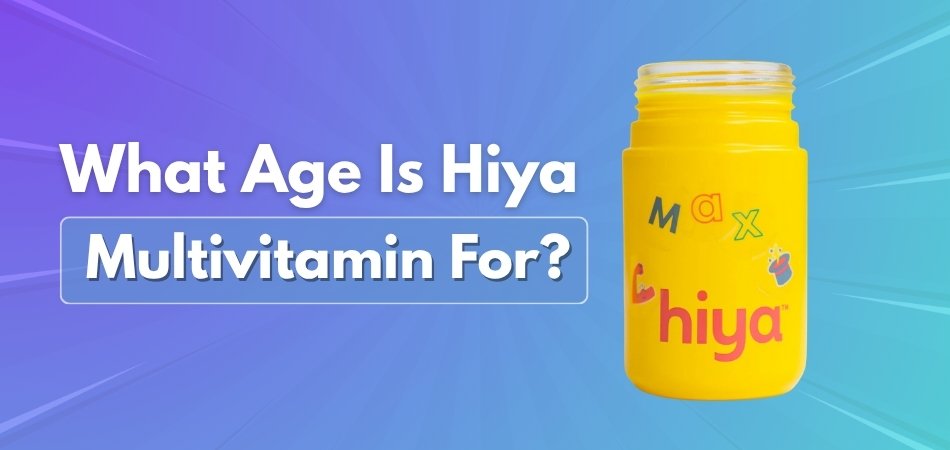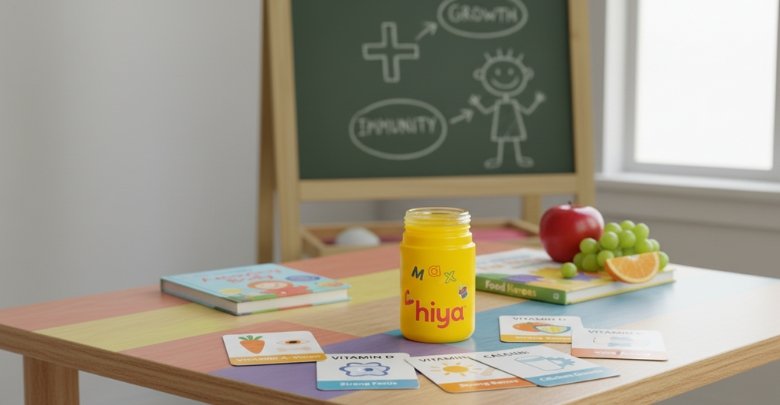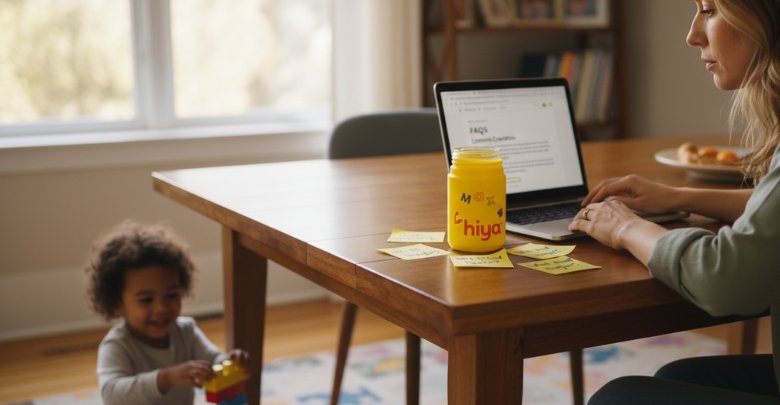Parents often wonder when the right time is to start giving their kids vitamins, especially with so many options available today. It’s natural to feel cautious because every child’s growth journey looks different, and nutrition plays a huge role in shaping healthy habits early on.
So, what age is Hiya multivitamin for? Hiya is carefully made for children between ages 2 and 12, filling the nutrition gaps that arise during their most important growth years. It’s designed to support kids as they learn, play, and build strong foundations.
Knowing the right age helps parents feel confident and informed when making choices about their child’s health. Keep reading to discover how Hiya supports different age groups and why it stands out as a smart option for families.
What Age Is Hiya Multivitamin For?
Parents often ask the same question when choosing supplements: what age is right for starting Hiya? From its development history to customer reviews, Hiya was created with children in mind, especially during the years when nutrition from food alone may fall short. Here’s the full age breakdown to guide parents.

Starting Age: 2 Years Old
Hiya is generally recommended for children beginning at age two. At this stage, kids are more independent with meals but still miss important nutrients because of picky eating. Hiya’s chewable format makes it simple and safe for daily use. Parents often find that this is the earliest suitable age to begin supplementation.
Toddlers (2–3 Years Old)
Toddlers are curious eaters but rarely consistent with balanced meals. This makes them highly likely to develop nutritional gaps, and many parents choose Hiya for toddlers because it offers natural vitamins without sugar or preservatives. Since toddlers grow quickly, starting at this stage helps ensure they have the nutritional foundation to support healthy development.
Preschool and Early School Kids (4–7 Years Old)
This is the age when children become more active, start school, and need steady energy throughout the day. Yet many still refuse vegetables or rely on snacks. Hiya is particularly useful for this range because it covers essential vitamins and minerals, keeping kids supported as they balance growth, learning, and early classroom routines.
Older Children (8–12 Years Old)
Older kids face growth spurts and new pressures from school activities. Although their diets may improve slightly, gaps still remain, especially with processed foods becoming common. Hiya remains suitable through this stage, continuing to supply the vitamins and minerals needed for focus, resilience, and healthy development. It bridges nutrition during these important preteen years.
Not for Infants Under 2 Years Old
Hiya is not intended for babies younger than two years old. Infants have very specific nutritional needs best met through breast milk, formula, or pediatric guidance. Introducing chewable vitamins too early may pose risks like choking hazards. Parents should wait until at least age two before considering Hiya as part of a child’s routine.
In simple terms, Hiya multivitamin is designed for children between the ages of 2 and 12. It gives toddlers, preschoolers, and older kids the right nutritional backup when food alone isn’t enough. For infants under 2, Hiya is not recommended, and parents should rely on pediatric advice before considering any supplement.
Why Do Kids Need Multivitamins at Different Ages?
Children don’t grow at the same pace, and their nutritional needs shift as their bodies and minds develop. What works for a toddler is not always enough for a preteen. This is where multivitamins can step in to support them differently at each stage of childhood.
Growth Patterns Change With Age
In early years, kids experience steady growth, but during later childhood, growth spurts demand more nutrients. Multivitamins help ensure that, no matter the stage, children get the right balance of vitamins and minerals to match their development speed.
Diet Habits Are Never the Same
Toddlers often reject certain foods, while older kids may lean toward processed snacks. Because eating habits are unpredictable, multivitamins work as a safety net to make sure essential nutrients aren’t missed, regardless of age or diet style.
Energy and Activity Levels Differ
Younger children use energy for basic growth, while school-aged kids need extra fuel for learning, sports, and activities. Multivitamins help provide steady support, giving kids what their bodies require to keep up with different demands at each age.
Brain Development Requires Support
The brain needs to evolve as children grow; toddlers need nutrients for forming new connections, while older kids rely on vitamins for concentration and memory. Multivitamins ensure consistent mental support, helping kids focus and learn better across various stages.
Immunity Needs Constant Strengthening
Children are exposed to different germs at different ages, from daycare to classrooms. Their immune systems require ongoing support. Multivitamins give an extra layer of protection, helping kids stay healthier no matter what age they’re in.
Kids need multivitamins at different ages because their growth, diets, and daily challenges keep changing. A steady supply of nutrients makes sure they don’t fall behind in health, energy, or learning during these important years of development. Many parents also mention in a Hiya review that consistent use helps cover these changing needs with confidence.
Key Nutrients in Hiya and Their Role in Growth
Hiya stands out because it isn’t just another chewable. It’s filled with nutrients chosen carefully to support children’s growth in natural ways. Each vitamin or mineral plays its own role in building stronger, healthier kids. Here’s a closer look at some of the most important ones.

- Vitamin A – Vision and Immune Support: Vitamin A is vital for healthy eyesight and a strong immune response. Children need clear vision for learning and exploration, and this nutrient helps protect their eyes while also acting as a guard against common illnesses.
- Vitamin C – Healing and Defense: This vitamin helps children recover from cuts and bruises faster while boosting their body’s natural defenses. It also supports iron absorption, ensuring kids get the most from the foods they eat.
- Vitamin D – Bone and Teeth Strength: Vitamin D plays a major role in building strong bones and teeth. Because many kids don’t get enough sunlight or dairy, this nutrient becomes essential to prevent weaknesses and support long-term bone health.
- B Vitamins – Energy and Mental Focus: B vitamins like B12, B1, and B6 keep kids energized and help their brains stay sharp. They play a role in concentration, mood, and memory, ensuring children are ready for schoolwork and daily activities.
- Zinc – Growth and Immunity: Zinc is known for helping children grow taller and stronger. It also supports wound healing and strengthens immunity, reducing the chances of frequent colds or infections that can slow down development.
- Calcium – Structural Growth: Calcium is a must for building bones and teeth that last. It works together with Vitamin D, ensuring the structure of the body grows steadily. Without enough calcium, kids may face weak bone development.
- Folate – Cell Growth and Development: Folate (Vitamin B9) is essential for forming new cells and supporting healthy tissue growth. This is especially important for kids as their bodies constantly produce new cells during growth years.
The nutrients in Hiya are carefully chosen to target different parts of a child’s growth, from bones and brain to immunity and energy. Together, they create a complete balance that supports children’s physical and mental development every single day.
Comparing Hiya with Other Children’s Multivitamins
Parents often find it tricky to choose the right vitamin when the shelves are crowded with gummies and colorful packaging. Many products look appealing but don’t always focus on children’s true health needs.
A clear comparison helps parents see how Hiya stacks up against typical children’s multivitamins. Many families even search for a Hiya vs First Day comparison to better understand which brand fits their child’s needs.
| Feature | Hiya Multivitamin | Typical Children’s Multivitamins |
| Sugar Content | Sugar-free, naturally sweetened with monk fruit | Often loaded with added sugar and syrups |
| Ingredients | Made from real fruits and vegetables, no fillers or dyes | Includes artificial flavors, colors, and preservatives |
| Format | Chewable tablets, safe for teeth | Gummies that can stick to teeth and cause cavities |
| Expert Input | Developed with pediatricians and nutritionists | Usually mass-produced with limited expert guidance |
| Environmental Impact | Reusable glass bottle with refill pouches | Disposable plastic bottles every month |
| Taste | Naturally flavored, kids enjoy without extra sugar | Sweetened heavily to mimic candy taste |
This comparison shows that Hiya is designed differently, with long-term health and safety in mind rather than short-term appeal. By removing sugar, using natural sources, and prioritizing expert input, Hiya offers a balanced choice parents can trust for their children.
Pediatrician Recommendations on Age and Usage
Parents often look to pediatricians for reassurance before starting supplements. Doctors highlight not only the formula but also the way vitamins are used safely. Hiya fits well with these professional views because it combines expert input, simple usage, and parent-friendly guidance.
Backed by Pediatric Collaboration
Hiya’s formula was designed with pediatric input, focusing on nutrients children often miss in their diets. Pediatricians value that the vitamins are clean, free of sugar, and balanced. This collaboration helps parents feel confident about choosing Hiya as a trusted daily supplement for kids.
Safe Daily Use Guidance
Pediatricians recommend limiting children to one chewable per day, as more is unnecessary and may cause excess intake. Hiya’s design makes this easy for parents, ensuring kids get steady nutritional support without overdose concerns. Simplicity and safety are the key takeaways here.
Encouragement for Routine Building
Doctors often suggest pairing Hiya with meals, such as breakfast or dinner, so it becomes a natural part of a child’s day. Establishing a routine helps children accept vitamins willingly and ensures consistent use, which is far more effective than giving them occasionally or irregularly.
Monitoring Alongside Diet
Pediatricians emphasize that vitamins are not meal replacements. Hiya should be used alongside a balanced diet rich in fruits and vegetables. Doctors remind parents to keep encouraging healthy eating habits, while relying on Hiya only as additional support for covering daily nutritional gaps.
Parental Consultation First
Even though Hiya is broadly safe, pediatricians recommend checking with a doctor before starting. Each child’s health history is unique, and consultation ensures supplements don’t interfere with existing conditions or treatments. This extra step provides peace of mind for parents introducing Hiya.
Pediatricians generally support Hiya as a safe choice for children, provided it’s used thoughtfully. By sticking to one chewable daily, combining it with balanced meals, and consulting a doctor when needed, parents can confidently make Hiya part of their child’s healthy routine.
Common Concerns Parents Have About Hiya Multivitamin
Parents naturally pause before introducing something new to their child’s daily routine. Hiya is widely trusted, but certain concerns still come up repeatedly. Addressing them clearly can help parents feel confident in their choice.

Parents Worry About Safety First
Many parents are cautious about introducing vitamins. Hiya addresses this concern by avoiding preservatives, dyes, and sugar. Pediatric input in its development helps reassure families that it’s safe when used responsibly, but parents still prefer consulting their doctor first.
Taste Is a Frequent Concern
Children often reject vitamins because of flavor. Parents worry about wasted supplements if kids refuse them. Hiya responds to this by using monk fruit and fruit blends, making its chewable tablet enjoyable so children accept it without resistance.
Side Effects Raise Questions
Parents often ask whether Hiya could cause unwanted effects. While the formula is gentle, the concern is valid. The only real issue comes from taking more than one tablet, so supervision and proper storage are important to avoid accidental overdosing.
Price Can Feel Like a Barrier
Cost is a major consideration for families. Parents sometimes see Hiya as more expensive than common gummy vitamins. However, the higher price reflects cleaner ingredients, eco-friendly packaging, and expert-led formulation, which reassures many families that the value outweighs the cost.
Subscriptions Seem Inconvenient at First
Parents may hesitate about committing to a subscription. The concern is whether it locks them in or creates extra hassle. In reality, Hiya offers flexible monthly deliveries with easy cancellation or adjustments, but the worry is still natural for first-time buyers.
These concerns, including safety, taste, side effects, cost, and subscriptions, are common among parents considering Hiya. Understanding how each is addressed helps families move forward with confidence, knowing that their children are getting reliable and carefully developed nutritional support.
Tips for Parents When Starting Kids on Hiya
Introducing Hiya to your child can feel easier when it’s handled with a bit of planning. Parents don’t need complicated steps; instead, small, practical actions help children accept vitamins naturally. These tips ensure consistency while making the process enjoyable and stress-free.
- Introduce It with Meals: Offer Hiya alongside breakfast or dinner so it feels like part of daily eating. Connecting vitamins with meals reduces the chance of forgetting and helps children see it as a normal part of life.
- Make It Fun for Kids: Encourage your child to decorate their refillable Hiya glass bottle with stickers. This playful step makes vitamins more personal, turning daily use into something fun rather than something they resist or forget.
- Store It in a Visible Spot: Place the Hiya bottle where both you and your child can easily see it. A visible reminder works better than reminders alone, making consistency natural and keeping vitamins from being overlooked.
- Encourage Routine, Not Reward: Introduce Hiya as a daily health routine, not as a special treat. This approach prevents children from bargaining over vitamins and helps them view it as an everyday responsibility they naturally follow.
- Stay Consistent Each Day: Give Hiya at the same time daily, whether at breakfast or bedtime. A predictable routine builds habits children can rely on, ensuring steady support without creating confusion or inconsistency in their schedule.
Parents can set their children up for success by keeping Hiya visible, consistent, and fun. With these simple strategies, vitamins stop feeling like a struggle and become a regular, positive part of growing up strong and healthy.
Frequently Asked Questions
Parents often finish reading about Hiya and still have a few practical questions in mind. These FAQs cover the little details that help families feel more comfortable before making a final decision.
Can Hiya Be Taken With Other Supplements?
Yes, Hiya can usually be taken with other supplements, but it’s best to check with a pediatrician first. Doctors can confirm if your child needs both. This avoids duplication or unnecessary intake of certain nutrients.
How Long Does One Bottle of Hiya Last?
A single Hiya bottle is meant to last for 30 days with one tablet daily. Parents receive monthly refills to keep the routine consistent. This makes it easy to stay on track without interruptions.
Does Hiya Need to Be Refrigerated?
No, Hiya does not require refrigeration. It’s shelf-stable and safe at room temperature. Just keep the bottle in a cool, dry place, away from heat or moisture, to preserve quality.
What Makes Hiya Different From Gummy Vitamins?
Hiya is a chewable tablet, not a gummy, and contains no added sugar or sticky ingredients. Gummies often damage teeth and lack balanced nutrients. Hiya avoids these issues while still tasting enjoyable for kids.
Can Parents Adjust the Subscription Easily?
Yes, Hiya offers flexible subscription management. Parents can pause, adjust, or cancel anytime through their account settings. This ensures families only receive what they need without worrying about being locked into a long plan.
Is Hiya Suitable for Picky Eaters?
Absolutely, Hiya was designed with picky eaters in mind. Its natural sweetness and chewable form make it easy for kids to accept. Parents often report success even with children who normally resist supplements.
How Do Kids Personalize Their Hiya Bottle?
Hiya sends a reusable glass bottle with stickers that children can use to decorate. This makes the experience fun and personal. When kids feel involved, they are more motivated to take their vitamins daily.
Concluding Lines
Choosing the right vitamin for your child starts with knowing if it matches their age. Understanding what age is Hiya multivitamin for gives parents the clarity they need before adding it to their child’s routine.
Hiya focuses on children between 2 and 12 years, the stage when growth, learning, and health need extra care. This makes it a practical option for parents who want balanced support without unnecessary additives.
By knowing when Hiya fits best, parents can feel confident in their choice. It’s simple, safe, and designed to meet the needs of growing kids, while also being something children genuinely enjoy taking every day.






